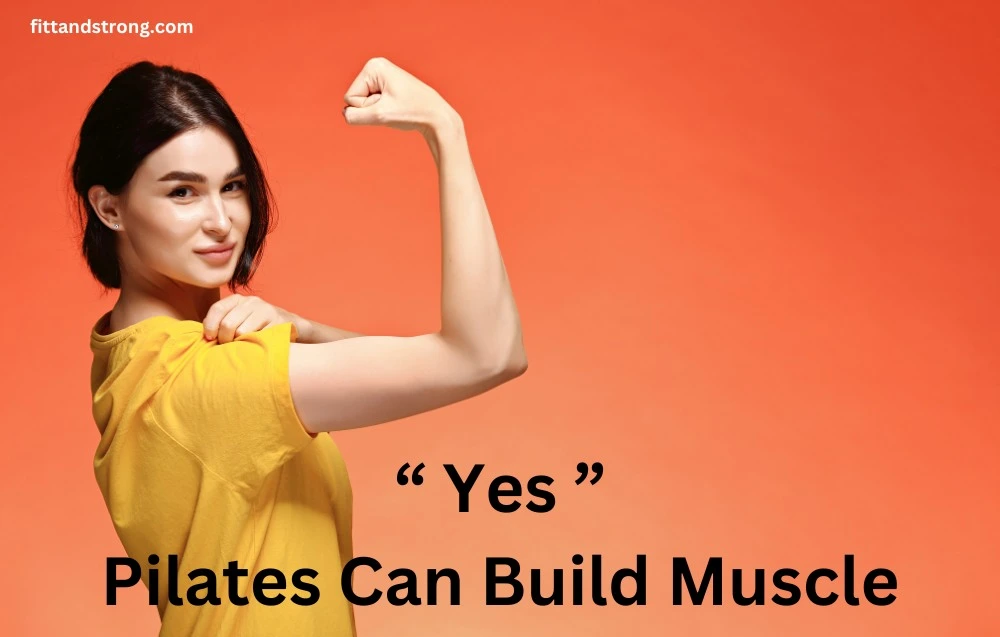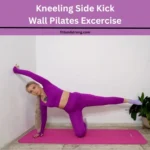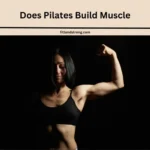The answer to whether Pilates builds muscle is a bit complex, but Yes, Pilates can help build muscle, just not as much as bodybuilders gain.
Pilates and strength training are two distinct Types of Exercise methods. In Pilates, heavy weights are not lifted; instead, a higher count is used to achieve lean muscle gains. On the contrary, strength training involves lifting heavy weights with a lower count to gain bulky muscles.
Research shows that muscle growth happens when muscle building happens faster than muscle breakdown. However, this growth doesn’t occur during the workout itself but during rest periods.
Did you Ever ponder why Pilates practitioners sport such toned physiques without lifting heavy weights? Here’s the scoop that might just change how you view fitness forever.
Must Read: What Happens When You Do Pilates For Everyday
Can Pilates Build My Muscles

Yes, Pilates has the potential to improve your muscularity and build muscles, focusing on strength, flexibility, and developing lean muscle instead of bulk. The real question isn’t about Pilates’ ability to build muscle, but rather, why the conversation around women and muscle building needs a new perspective.
Whether it’s a child, an elderly person, or a woman, everyone benefits from building muscle. The old idea that women should stay away from muscle building for fear of getting “too bulky” is just a myth that we need to clear up.
Building muscle with Pilates is great for everyone because it helps keep bones healthy, speeds up metabolism, and improves overall physical and mental health.
Can Women Build Muscle with Pilates
Yes, women can build muscle but not as much as men. The main hormone for muscle growth, testosterone, is higher in men, limiting women’s muscle size despite weight training. A study using MRI on 268 men and 200 women showed men have more upper body muscle mass.
However, muscle growth works similarly for both genders. Women can indeed gain strength and tone their bodies with Pilates. Yet, for significant muscle building, Weight Training, Rest, Diet, and Nutrition are essential.
Understanding Pilates and Muscle Growth
Did you know that the Pilates exercise system we’re all curious about was developed by Joseph H. Pilates? He didn’t call it Pilates; it was Contrology to him until after his death. Over the course of his life, this system evolved, as he created new exercises and New Pieces of Equipment.
“Ever wondered if Pilates can pump up your muscles? Here’s the lowdown: Pilates isn’t just about looking good – it’s about building strength from the inside out. Unlike traditional weightlifting, which bulks you up, Pilates focuses on lean muscle growth and endurance. This method works your body balanced, targeting core stability, flexibility, and muscular symmetry.
But here’s the kicker: Muscle growth in Pilates comes from a sophisticated dance of muscle contraction and relaxation, all while improving your posture and body alignment.
It’s about getting stronger for daily activities, not just lifting heavy stuff. And guess what? Research backs this up, showing that Pilates can indeed lead to improved muscle tone and functional strength without the bulk.
So, if you’re on the hunt for a workout that strengthens, tones, and aligns, giving you that sleek, toned look while keeping you agile and injury-free, Pilates could be your best workout. proving you don’t need heavy weights to see changes in your muscle definition.
How Does Pilates Cause Microtrauma in Muscles?
Did you know that in people aged 20-40, muscle mass typically ranges from 63-89%? Men usually have between 75-89%, while women have a bit less, between 63-75.5%. And the amount of muscle mass can affect your health, shape, and fitness levels.
Pilates exercises have the power to increase muscle mass. Whether you’re a man or a woman, building muscle depends on how much microtrauma your muscles experience during exercise.
Microtrauma, or tiny tears in the muscle, can happen through four main types of muscle contractions: isometric, isotonic, concentric, and eccentric. You’ll find these contractions in both Pilates and strength training. However, Pilates tends to cause less microtrauma compared to weight training because the load (or weight) you’re working against in Pilates is usually lighter than in weight training.
Ever noticed that ache you feel after working out? That’s due to microtrauma. When your body repairs these tiny tears, a process known as muscle hypertrophy occurs, changing the size of your muscles.
Muscle Hypertrophy: Pilates vs. Strength Training
After experiencing microtrauma, whether muscles build or get lost truly depends on the hypertrophy process. To explain this briefly, I’ve used a table to help you understand the Muscle hypertrophy resulting from Pilates vs strength training.
Here is Pilates Vs Strenght Training:
Feature | Pilates | Strength Training |
|---|---|---|
Primary Focus | Core strength, flexibility, postural alignment | Muscle size, muscular strength |
Muscle Growth | Sarcoplasmic hypertrophy, muscular endurance | Myofibrillar hypertrophy, increased muscle mass |
Training Type | Low-impact, bodyweight, resistance bands | High-impact, heavy weights |
Benefits | Improved posture, functional strength, flexibility | Greater muscle mass, enhanced metabolic rate |
Ideal For | Those seeking tone, body balance, injury recovery | Individuals targeting bulk, powerlifting |
Equipment | Mats, reformers, resistance bands | Barbells, dumbbells, weight machines |
Technique | Controlled movements, mind-body connection | Explosive movements, progressive overload |
Recovery | Emphasizes recovery through movement, alignment focus | Requires rest days for muscle repair |
Complementary Nature | Enhances other forms of exercise with core stability | Builds overall strength, beneficial for all activities |
Types of Pilates to Build Lean Muscles
Mat-based Pilates offers a foundation, using body weight as the primary resistance. This method enhances core stability, balance, and movement coordination, but its effort to build muscle may hit a plateau due to limited load.
Reformer-based Pilates, on the other hand, incorporates weighted springs to increase resistance load, targeting stabilizing and postural muscles. It’s essential for improving joint control and core stability, providing a more intense workout.
While both types contribute to a hard workout, the outcome in muscle building varies. Reformer Pilates tends to offer a higher load, potentially avoiding the plateau effect seen with mat-based practices. Yet, both forms improve strength and balance without the risk of injury associated with heavier training exercises like squats and deadlifts.
This overview reflects how both Mat-Based and Reformer-Based Pilates can be part of a balanced approach to strength training, especially for those aiming to build muscle in a safe and controlled manner.
How Does This Work
Ever noticed How Pilates transforms Bodies, making them look well-trained and balanced? It’s because Pilates targets those often underdeveloped muscle groups, waking them from their dormant state. Unlike hours on a Stairmaster or running every day, Pilates ensures all muscles get a turn to activate and strengthen.
This method isn’t just about flexibility; it’s a deep dive into core stability. When muscles that are usually chilling, waiting to be called upon, finally activate, you start feeling the magic of Pilates. It’s a game-changer for those stuck in under-active lifestyles, especially for women who’ve been told their muscle building capabilities are limited.
By mixing private sessions with group classes, your Pilates Instructor can tailor Pilates to meet your fitness level and needs. This personal touch ensures you’re not just moving your body but learning how to use your muscles effectively, ensuring every session pushes you closer to your strength goals.
The Benefits of Pilates for Overall Physical Health
Pilates, a versatile and accessible exercise, has been a subject of intrigue when it comes to building muscle, particularly among women. With its unique approach to enhancing core strength, posture, flexibility, and mind-body awareness, Pilates stands out as a beneficial practice for individuals across all fitness levels and ages.
But how exactly does it contribute to muscle building and overall physical health? Let’s dive into the Specific Benefits Pilates Offers.
Improved Core Strength
A primary aim of Pilates is developing a strong, stable core, which is pivotal for supporting the spine, preventing injuries, and boosting physical performance in various activities.
Enhanced Posture
Pilates exercises meticulously align the body and enhance posture. This not only helps reduce the risk of injury but also alleviates common discomforts like back and neck pain.
Increased Flexibility
Utilizing dynamic stretching and muscle lengthening techniques, Pilates works to expand flexibility and range of motion. These improvements are key for preventing injuries and enhancing mobility.
Better Balance and Coordination
Pilates challenges balance and coordination through precise, controlled movements. Sharpening these skills can significantly enhance performance in a variety of sports.
Mind-Body Connection
Pilates promotes mindfulness, deep breathing, and concentration, deepening the connection between mind and body. This mental engagement helps reduce stress and foster mental clarity.
Should You Add Pilates or Strength Training To Your Workouts?
Pilates truly offers a unique blend of strength, flexibility, and mind-body awareness, making it a standout choice for those looking to enhance their physical health. It bridges the gap between mindful relaxation and physical resilience, promoting relaxation while also relieving stress.
According to the Victoria Health Government, this training method not only improves posture but also aids in preventing musculoskeletal injuries, underscoring its value beyond mere exercise.
Incorporating Pilates can significantly improve posture and prevent musculoskeletal injuries, making it a smart addition for anyone, especially those with back pain or bad knees. It’s a versatile training method that boosts body awareness, aiding in recovery from joint and spinal injuries without stopping your fitness progress.
Even if you love the gym, Pilates on off-training days can keep you moving instead of sitting on the couch. Engaging in Pilates for active recovery can lessen tiredness and lower the accumulation of lactic acid, improving the circulation of blood to the muscles and joints. It keeps your core and back muscles strong, supporting your strength workouts.
For those dealing with sports injuries or repetitive strain injuries, like tennis elbow or tendonitis, Pilates allows you to maintain conditioning while healing. You don’t have to pause your fitness journey; Pilates enables you to stay active, focusing on gentle but effective exercises.
Ultimately, the choice between Pilates and strength training depends on your preferences and health goals. Combining them, however, can improve your overall strength, keep your spine healthy, and increase flexibility. Pilates can be that minimal effective dose to transform your body for the better.
FAQs
Is Pilates as Effective as Lifting Weights?
While Pilates is excellent for building core strength and engaging muscles differently, strength training, including back squats and compound movements, tends to make you stronger overall. Both have unique benefits, but for sheer muscle gain, lifting weights is more effective.
Does Pilates Make You Look Muscular?
Pilates primarily aims to tone your muscles, giving you a lean and toned appearance rather than bulkiness. By working both smaller muscles and larger muscle groups, it enhances your overall body shape.
Why Am I Bulking Up with Pilates?
You might feel your muscles growing because Pilates makes you activate smaller muscles you’re not accustomed to using in your day-to-day routine. This experience of muscle hypertrophy means those soft, underused muscles are becoming firm, which is a good thing. It’s not about bulking up but strengthening and toning.
Is Pilates Alone Enough Exercise?
While Pilates can make you stronger, especially if you’re starting with a lower fitness level or a weak core, it’s not ideal to rely solely on it to improve full body strength. Diversifying beyond mat workouts is key.
Can Pilates Replace Weight Training?
Pilates can enhance mobility, core strength, and improved functionality, making it great for feeling healthy. However, for lifting heavy weights and achieving muscle hypertrophy, weight training is better suited for those specific goals.
What is Better: Pilates or Gym?
Pilates training holds several advantages over gym training, offering strength, flexibility, cardiovascular fitness, and breathing improvements in one session, making it more efficient. It’s low-impact and suitable for beginners or those recovering from injuries.
Final Verdict
Pilates isn’t just a trend; it’s a comprehensive workout that blends strength, flexibility, and mindfulness. Perfect for everyone, including women, it builds lean muscle and enhances physical health without the bulk.
By focusing on core stability and preventing injuries, Pilates complements strength training, making it an essential part of your fitness routine. Whether recovering from injury or aiming for a toned physique, incorporating Pilates offers balanced benefits for a stronger, healthier you.





